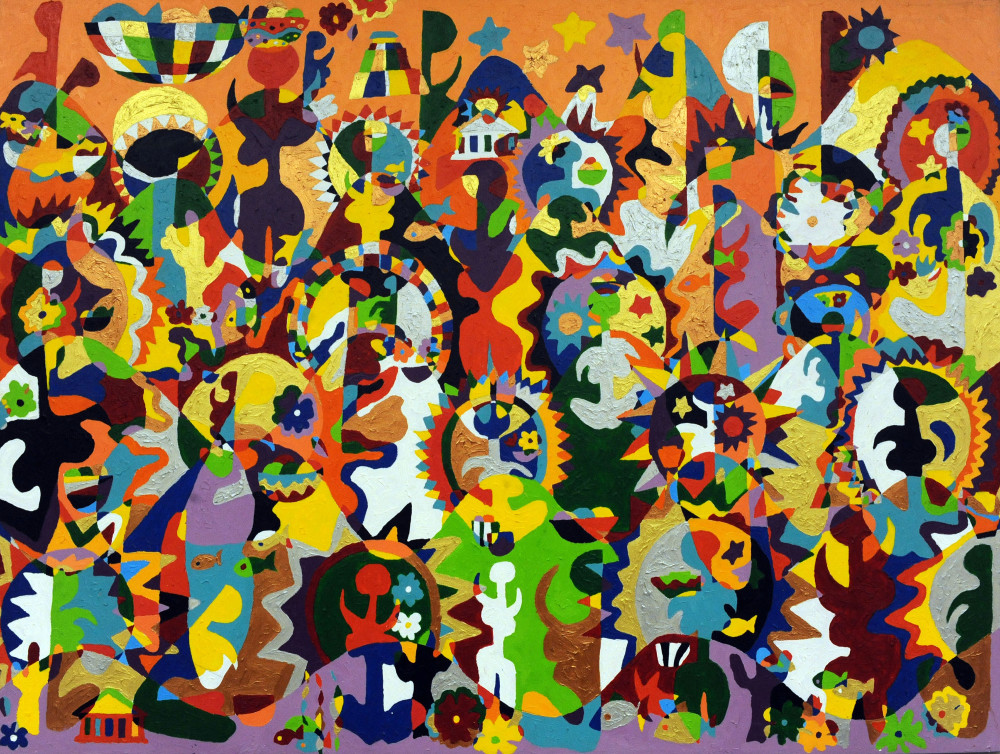By Andrea K. McDaniels
The Baltimore Sun.
BALTIMORE
The paintings lay everywhere.
Stacked in neat, methodical piles, they filled every room in the tiny apartment. The dining room, kitchen, bathroom, bedroom, all full of artwork.
Cheryl Maxwell stood near the doorway staring at it all in awe before becoming so overwhelmed with emotion she had to sit down.
“Surreal,” she thought.
The paintings were the work of her younger sister, Carolyn Anne Watts, who committed suicide at the age of 56. The family didn’t know of the secret art until after her death in 2010.
Watts had suffered from depression her whole life, but her sister hadn’t realized how it had consumed her. She saw all the emotions, and the ups and downs her sister suffered, painted on the canvases. Guilt and sadness filled Maxwell’s heart. Maybe, she thought, she could have done more.
While it was too late for her sister, it wasn’t for others. Maxwell soon saw how she could open up a dialogue about mental illness through the paintings that had stopped her in her tracks, and maybe save other lives. There were nearly 170 pieces of artwork, she later counted. Enough to fill a small art gallery.
Now, many of those acrylic works get displayed throughout the state of Maryland as part of a traveling art exhibit Maxwell created in her sister’s name. At each stop, there are discussions about mental health, particularly in the African-American community.
The works were first displayed at Reid Temple AME Church in Glenn Dale, Md., during a conference focused on strengthening the black family. The paintings traveled to Coppin State University during a daylong seminar with the Black Mental Health Alliance for Education and Consultation Inc. And now the exhibit hangs in community rooms at Chase Brexton Health Care in Baltimore in conjunction with discussions about recognizing mental health problems, increasing access to services and erasing the stigma attached to such disorders.
As it does in some households, mental illness ran in Watts’ family, but it was never discussed, her sister said. The siblings’ mother suffered from depression and was largely emotionally unavailable to her children.
“We were always told that we were feeling blue,” Maxwell said. “But we knew it was much more than that.”
Maxwell suspects that art became a coping mechanism for her sister, whose condition worsened after her longtime partner died.
“In the workings of her mind, she may have decided it was her best medication,” Maxwell said.
Looking back, she wonders if her sister also used art to cope as a child. She remembered Watts sitting at the kitchen table, intricately making paper dolls with their own outfits and jewelry amid the chaos around her.
Watts was diagnosed with depression after she sought help while studying art at the University of Maryland in the early 1980s.
“She just couldn’t remove herself and go draw paper dolls anymore,” Maxwell said. “It was real life now.”
She managed the illness while maintaining a 4.0 grade point average and working in the dining hall. After graduation, she worked as a makeup artist and in the shoe department at The Hecht Co. and later Macy’s.
In her later years, Watts turned reclusive, often barricading herself for days in that small apartment. Maxwell hadn’t seen her in weeks in the fall of 2010 when she committed suicide. Watts lay dead for days before her body was found in the bathroom after tenants reported a foul smell. She had hanged herself from the shower rod.
Maxwell tried to get a picture of her sister’s struggle through the paintings. Some were all in browns, perhaps done on dark days. Others were bright and colorful, maybe on up days. Many were busy and cluttered with many elements, suggesting someone struggling with an array of emotions.
Larry Poncho Brown, a Baltimore artist who has dealt with depression, said it is not uncommon for people to bury themselves in their work to help balance their emotions. Brown, who helped Maxwell catalog and figure out what to do with her sister’s paintings, said he thinks Watts’ work shows that she likely dealt with obsessive compulsiveness and depression.
Historically, some of the world’s greatest artists suffered from mental disorders that likely influenced their work: Paul Gauguin, Georgia O’Keeffe and Vincent van Gogh, to name a few. Also like Watts, many suffered in silence.
Art has become an important therapeutic tool for psychologists and counselors to get clients, particularly children, to express feelings they might not be able to verbalize.
buy zithromax generic buy zithromax online no prescription
Maxwell wishes she had reached out to her sister more. Through her sister’s art, Maxwell hopes to break the cycle of silence that engulfs mental illness in families like her own.
“I think in the African-American culture especially there is an overall stigma of needing to do well and seem well,” said Harriette Wimms, the child, adolescent and family behavioral health program manager at Chase Brexton. “There is the idea that one is to pull themselves up by their bootstrap and go to work and do what you need to do.”
Maxwell is working on moving the gallery of paintings to more locations. She sells some of the pieces to raise money for a foundation she started in her sister’s name, the Carolyn Anne Foundation.
Maxwell has a special interest in children because, perhaps if her sister’s depression had been treated years ago, she’d still be here today.














































































































































































































































































































































































